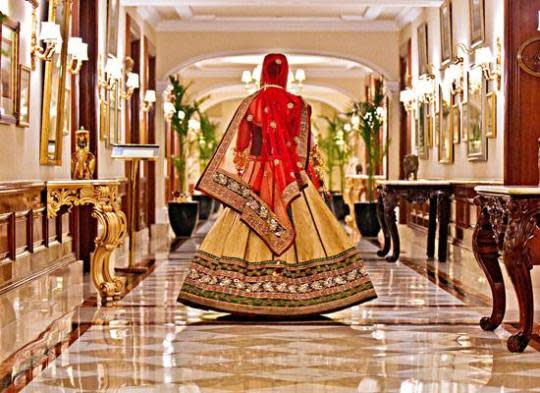
And there is a bride all dolled up in her wedding finery seizing every moment against a galloping heart, counting steps towards the mandap, totally oblivious to the array of humiliations lurking in her way to the laced up wedding. If you thought dowry is the only evil associated with Indian marriages, it’s time to revisit every single memory of the recent wedding you’ve attended. If the memories have faded away already, let me walk you through the most absurd wedding rituals followed within various communities. Some centuries ago, these rituals were deliberated to put the girl and her family in a place of disgrace, but they have shamelessly survived through the ages and their snippets can still be found in the developed society of Modern India.
I know a lot of people will find this criticism offensive, and bring out their own justifications, but some of these clearly fail to draw any pertinence for our generation.
Kashiyatra – An inevitable part of Tamil weddings, Kashiyatra might appear fun, but the philosophy behind the ritual when studied in depth might not appeal to the humor. The travesty begins with the groom setting for a mock pilgrim, abandoning the marriage and other pleasures associated with ‘sansarik’ life. Fearing his daughter’s disrepute, the bride’s father pleads to the groom to accept his daughter as his bride. It’s up to the groom and his sweet will if he readily grants the old man’s wish or delays the process.
Bride’s Family Washing Groom’s Feet – This tradition was incepted back in the day when groom had to travel bare feet all the way to the bride’s house and the members of the girl’s family washed the feet of the groom and his clan. But it is demeaning that even in the 21st century when the groom arrives at the wedding venue riding the most expensive cars, among many communities the males of the bride’s family still wash the the groom’s and his relatives’ feet.
Bride Toweling the Groom’s Feet With Her Hair - This one will give you diarrhea. Though induced during the pre-medieval ages, some orthodox families in rural Bengal are still following this tradition religiously. On the night of reception, known as Phoolshajja in Bengali, when the couple is expected to consummate their marriage, the new bride is made to wash the feet of the husband. But wait, there is more. This pedicure session is followed by the bride wiping off the groom’s feet with her long lustrous hair. Can you beat that?
Mother’s Banned from Partaking in Marriage – Patriarchy doesn’t spare any women, not even the one belonging to the groom’s clan. Vastly followed in Bengali marriages, the mother of the groom is not allowed to witness the marriage ceremony or even be present anywhere near the venue, lest her jealousy of losing her son to the daughter-in-law casts a curse on the happiness and prosperity of the couple.
Parents Forbidden at Daughter’s Matrimonial House – Followed across India (mostly) the girl’s family doesn’t eat at their daughter’s matrimonial house. But this ‘tradition’ has branched out in many variations customized by families over the years. In some cultures the bride’s parents don’t eat at her matrimonial home for one year past the wedding, and in some they are allowed to eat once the girl bears a son. In few families, if an unfavorable circumstance leads to the girl’s parents swallowing a few morsels at their daughter’s home, they have to buy back the food by paying a minimum shagun amount. This varies from 11 to 111 and in some cases goes up to 11111 rupees.
Balancing a Pot Tower on Head – “Must be able to strike a balance” is what every ‘bride wanted’ matrimonial ad reads. Some people in Bihar take these words a little too literally. To welcome her, the mother-in-law places a pot on the bride’s head. The bride is walked around, seeking blessings from the elders’ feet while balancing the pot on her head. Gradually more pots get added forming a pile of responsibilities on the girl’s head and she simultaneously performs other household chores balancing the pots on the top of her.
Apart from such recognized ‘customs’ there are few equally if not more derogating acts practiced in various remote corners of the country. Prakriti describes that her matrimonial bedsheet was confiscated by the elder women in the family and was minutely scrutinized for blood traces. Later she learnt that this lunacy was an age old practice followed in the household to certify the girl’s piety. In a different surrounding, as a married woman Madhavi was obliged to wear Shakha-Pola (Bengali matrimonial bangles), which she embraced with pride. The twist was, every time the couple picked up a fight, her ill-tempered husband got physical and the fragile Shakha-pola were turned into pieces. As an extension of the custom,(as preached by her mother-in-law) it was obligatory on Madhavi’s mother to pay for these broken bangles as long as she lived, or as I look at it, till the marriage survived. Most of these customs appear to have been designed just to reduce the girl and her family to the most insignificant form of God’s creation. Now if you agree with me, say aloud - WTF. If you hate me for condemning these traditions, hit the comment section and spew your hate. I am prepared for both!
yahoo.com
No comments:
Post a Comment